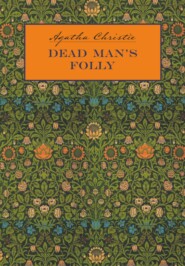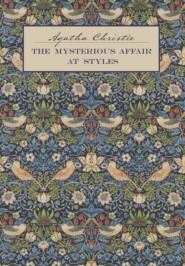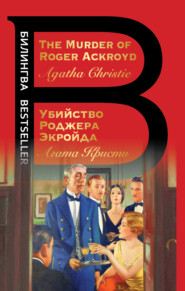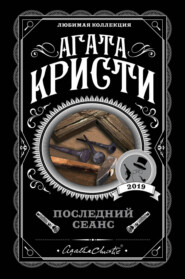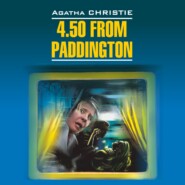По всем вопросам обращайтесь на: info@litportal.ru
(©) 2003-2024.
✖
Within a Wall: An Agatha Christie Short Story
Автор
Год написания книги
2019
Настройки чтения
Размер шрифта
Высота строк
Поля
Agatha Christie
A classic Agatha Christie short story, available individually for the first time as an ebook.Alan Everard is a struggling young portrait painter caught in a love triangle between his wife and his daughter’s godmother. But which of them does he love, and which one should he hate?
Within a Wall
A Short Story
by Agatha Christie
Copyright (#ulink_0e8d9049-e3d3-5a7c-9091-3f424a6d4817)
Published by HarperCollinsPublishers Ltd 1 London Bridge Street London SE1 9GF
www.harpercollins.co.uk (http://www.harpercollins.co.uk)
Copyright © 2008 Agatha Christie Ltd.
Cover design © HarperCollinsPublishers 2014
All rights reserved under International and Pan-American Copyright Conventions. By payment of the required fees, you have been granted the nonexclusive, nontransferable right to access and read the text of this e-book onscreen. No part of this text may be reproduced, transmitted, downloaded, decompiled, reverse engineered, or stored in or introduced into any information storage and retrieval system, in any form or by any means, whether electronic or mechanical, now known or hereinafter invented, without the express written permission of HarperCollins e-books.
Ebook Edition © JUNE 2014 ISBN 9780007560219
Version: 2017-04-17
HarperCollinsPublishers has made every reasonable effort to ensure that any picture content and written content in this ebook has been included or removed in accordance with the contractual and technological constraints in operation at the time of publication.
Contents
Cover (#uc0ba8b2f-c809-575b-aa29-94d65abd114b)
Title Page (#u3f29f237-ad74-587d-815b-ee37c7091ec9)
Copyright
Within a Wall (#u2904ff64-a136-50e6-8abd-124655a7833c)
Related Products (#litres_trial_promo)
About the Publisher (#litres_trial_promo)
Within a Wall (#ulink_e4159c0d-7fca-548a-835d-9682f091b71e)
‘Within a Wall’ was first published in Royal Magazine, October 1925.
It was Mrs Lemprière who discovered the existence of Jane Haworth. It would be, of course. Somebody once said that Mrs Lemprière was easily the most hated woman in London, but that, I think, is an exaggeration. She has certainly a knack of tumbling on the one thing you wish to keep quiet about, and she does it with real genius. It is always an accident.
In this case we had been having tea in Alan Everard’s studio. He gave these teas occasionally, and used to stand about in corners, wearing very old clothes, rattling the coppers in his trouser pockets and looking profoundly miserable.
I do not suppose anyone will dispute Everard’s claim to genius at this date. His two most famous pictures, Colour, and The Connoisseur, which belong to his early period, before he became a fashionable portrait painter, were purchased by the nation last year, and for once the choice went unchallenged. But at the date of which I speak, Everard was only beginning to come into his own, and we were free to consider that we had discovered him.
It was his wife who organized these parties. Everard’s attitude to her was a peculiar one. That he adored her was evident, and only to be expected. Adoration was Isobel’s due. But he seemed always to feel himself slightly in her debt. He assented to anything she wished, not so much through tenderness as through an unalterable conviction that she had a right to her own way. I suppose that was natural enough, too, when one comes to think of it.
For Isobel Loring had been really very celebrated. When she came out she had been the débutante of the season. She had everything except money; beauty, position, breeding, brains. Nobody expected her to marry for love. She wasn’t that kind of girl. In her second season she had three strings to her bow, the heir to a dukedom, a rising politician, and a South African millionaire. And then, to everyone’s surprise, she married Alan Everard – a struggling young painter whom no one had ever heard of.
It is a tribute to her personality, I think, that everyone went on calling her Isobel Loring. Nobody ever alluded to her as Isobel Everard. It would be: ‘I saw Isobel Loring this morning. Yes – with her husband, young Everard, the painter fellow.’
People said Isobel had ‘done for herself’. It would, I think, have ‘done’ for most men to be known as ‘Isobel Loring’s husband’. But Everard was different. Isobel’s talent for success hadn’t failed her after all. Alan Everard painted Colour.
I suppose everyone knows the picture: a stretch of road with a trench dug down it, the turned earth, reddish in colour, a shining length of brown glazed drainpipe and the huge navvy, resting for a minute on his spade – a Herculean figure in stained corduroys with a scarlet neckerchief. His eyes look out at you from the canvas, without intelligence, without hope, but with a dumb unconscious pleading, the eyes of a magnificent brute beast. It is a flaming thing – a symphony of orange and red. A lot has been written about its symbolism, about what it is meant to express. Alan Everard himself says he didn’t mean it to express anything. He was, he said, nauseated by having had to look at a lot of pictures of Venetian sunsets, and a sudden longing for a riot of purely English colour assailed him.
After that, Everard gave the world that epic painting of a public house – Romance; the black street with rain falling – the half-open door, the lights and shining glasses, the little foxy-faced man passing through the doorway, small, mean, insignificant, with lips parted and eyes eager, passing in to forget.
On the strength of these two pictures Everard was acclaimed as a painter of ‘working men’. He had his niche. But he refused to stay in it. His third and most brilliant work, a full-length portrait of Sir Rufus Herschman. The famous scientist is painted against a background of retorts and crucibles and laboratory shelves. The whole has what may be called a Cubist effect, but the lines of perspective run strangely.
And now he had completed his fourth work – a portrait of his wife. We had been invited to see and criticize. Everard himself scowled and looked out of the window; Isobel Loring moved amongst the guests, talking technique with unerring accuracy.
We made comments. We had to. We praised the painting of the pink satin. The treatment of that, we said, was really marvellous. Nobody had painted satin in quite that way before.
Mrs Lemprière, who is one of the most intelligent art critics I know, took me aside almost at once.
‘Georgie,’ she said, ‘what has he done to himself? The thing’s dead. It’s smooth. It’s – oh! it’s damnable.’
‘Portrait of a Lady in Pink Satin?’ I suggested.
‘Exactly. And yet the technique’s perfect. And the care! There’s enough work there for sixteen pictures.’
‘Too much work?’ I suggested.
‘Perhaps that’s it. If there ever was anything there, he’s killed it. An extremely beautiful woman in a pink satin dress. Why not a coloured photograph?’
‘Why not?’ I agreed. ‘Do you suppose he knows?’ ‘Don’t you see the man’s on edge? It comes, I daresay, of mixing up sentiment and business. He’s put his whole soul into painting Isobel, because she is Isobel, and in sparing her, he’s lost her. He’s been too kind. You’ve got to – to destroy the flesh before you can get at the soul sometimes.’
I nodded reflectively. Sir Rufus Herschman had not been flattered physically, but Everard had succeeded in putting on the canvas a personality that was unforgettable.
‘And Isobel’s got such a very forceful personality,’ continued Mrs Lemprière.
‘Perhaps Everard can’t paint women,’ I said.
‘Perhaps not,’ said Mrs Lemprière thoughtfully. ‘Yes, that may be the explanation.’
And it was then, with her usual genius for accuracy, that she pulled out a canvas that was leaning with its face to the wall. There were about eight of them, stacked carelessly. It was pure chance that Mrs Lemprière selected the one she did – but as I said before, these things happen with Mrs Lemprière.
‘Ah!’ said Mrs Lemprière as she turned it to the light.
It was unfinished, a mere rough sketch. The woman, or girl – she was not, I thought, more than twenty-five or six – was leaning forward, her chin on her hand. Two things struck me at once: the extraordinary vitality of the picture and the amazing cruelty of it. Everard had painted with a vindictive brush. The attitude even was a cruel one – it had brought out every awkwardness, every sharp angle, every crudity. It was a study in brown – brown dress, brown background, brown eyes – wistful, eager eyes. Eagerness was, indeed, the prevailing note of it.
Вы ознакомились с фрагментом книги.
Приобретайте полный текст книги у нашего партнера:
Приобретайте полный текст книги у нашего партнера:






